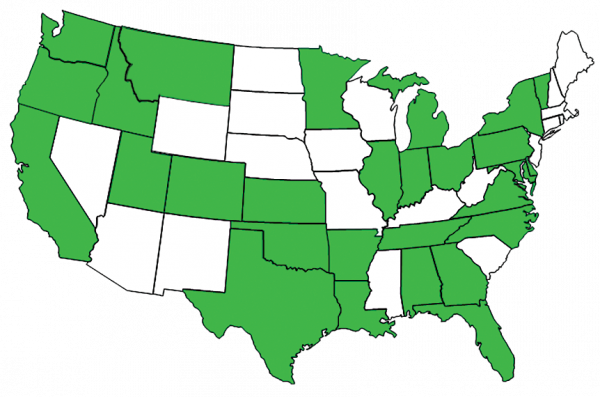Why Deer Must Remain Wild
White-tailed deer and other native wildlife belong to no one individual. They are held in trust by the Commonwealth for the benefit of all Virginians. As such, it is illegal for individuals to hold or confine deer or any other wild animals without a permit (Code of Virginia §29.1-521, 4VAC15-30-40). The only facilities allowed to possess native or exotic deer in the state are permitted by the Virginia Department of Wildlife Resources (DWR) for educational or rehabilitation purposes. These facilities, operated by people trained in deer husbandry, are inspected annually for humane care and compliance with state requirements for marking, record-keeping, and disease testing.

28 states with news reports of captive and free-ranging deer attacking people, 1988–2020 (N=74).
Deer, like all wild animals, are potentially dangerous to humans when threatened or confined. They become aggressive as they mature; males may attack, especially during the breeding season. Since 1988, at least 74 captive or free-ranging deer have attacked humans in the United States, resulting in 74 injuries and eight deaths.
Moving deer from one place to another or confining them within captive facilities increases the risk of transmitting diseases such as Chronic Wasting Disease (CWD) and Bovine Tuberculosis (TB). DWR remains vigilant in its attempts to prevent further spread of CWD, which exists in northwestern Virginia and adjacent areas in West Virginia.
What Happens To Tame Deer
When DWR discovers a tame deer that is held illegally, agency personnel must confiscate and humanely dispatch the animal. This is an unpleasant, but necessary duty. It would be irresponsible to ignore the human safety risks, inhumane conditions, and potential for disease transmission.
While anger is an understandable reaction to what seems a heartless act, euthanizing the animal is the best option. Why?
- A tame deer usually cannot be rehabilitated or released into the wild. Tame deer lose their natural fear of humans as well as their instincts for surviving in the wild. They can become very demanding for attention and food from their caretakers, which makes the deer dangerous. In some cases, hand raised deer have even caused human deaths by goring and trampling.
- Because biologists cannot be sure of the origin of an illegally held deer, or what the deer has been exposed to, they cannot release it into the wild or place it in a zoo or nature park. It could transmit a disease to other wildlife, to domesticated animals, or to the humans in the area where it is released.
What You Can Do To Help
To keep wild deer wild, you can do the following:
- If you find a fawn, please leave it where you found it. It is normal for female deer to leave their hidden fawns alone for long periods as the adults feed. When humans interfere, chances that a fawn will survive are generally reduced. A truly injured or orphaned wild animal can be taken to a licensed wildlife rehabilitator (see the Licensed Rehabilitators List or call the Wildlife Conflict Helpline at 1-855-571-9003).
- Report pet or tame deer to DWR. While you may hesitate to call please know that you are doing the right thing. Addressing the problem early will reduce the risks of human injury and disease transmission and help keep deer wild.

